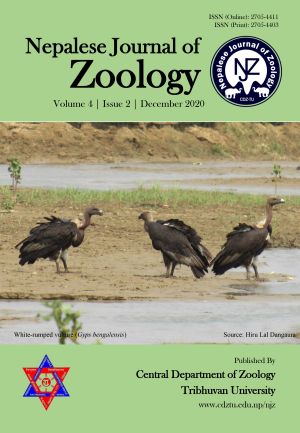Seasonal prevalence of Asian honeybee ectoparasitic mite Varroa destructor Anderson and Trueman, 2000 in Madanpokhara Apiaries, Palpa, Nepal
DOI:
https://doi.org/10.3126/njz.v4i2.33885Keywords:
Apis cerana, Climatic factors, Honeybee, Population variations, Varroa miteAbstract
The present study highlights the prevalence and seasonal variation of Varroa destructor Anderson and Trueman, 2000 in Apis cerana colonies at two apiaries (site-I and site-II) in Madanpokhara, Palpa district, Nepal. Altogether 498 varroa mites were collected from February to October 2017. The highest and lowest number of varroa mites were observed in March and September, respectively. The mites were observed higher in brood cells (54.84% and 52.51%) and lower in adult bees (10.39% and 9.59%) in site-I and site-II, respectively. The inner hive and outer temperature in site-I and II were ranged from 30°C to 34°C and 24°C to 32.4°C, 30°C to 33.5°C and 25.1°C to 32.3°C, respectively. Similarly, inner and outer hive humidity ranged from 41% to 61% and 40% to 68%, 40% to 60% and 41% to 65% at site-I and II respectively, differed significantly and correlated positively with mite population. Concern for honeybee health and conservation along with Nepali apiculture are also discussed in this paper.
Downloads
Downloads
Published
How to Cite
Issue
Section
License
This license enables reusers to distribute, remix, adapt, and build upon the material in any medium or format for noncommercial purposes only, and only so long as attribution is given to the creator.

